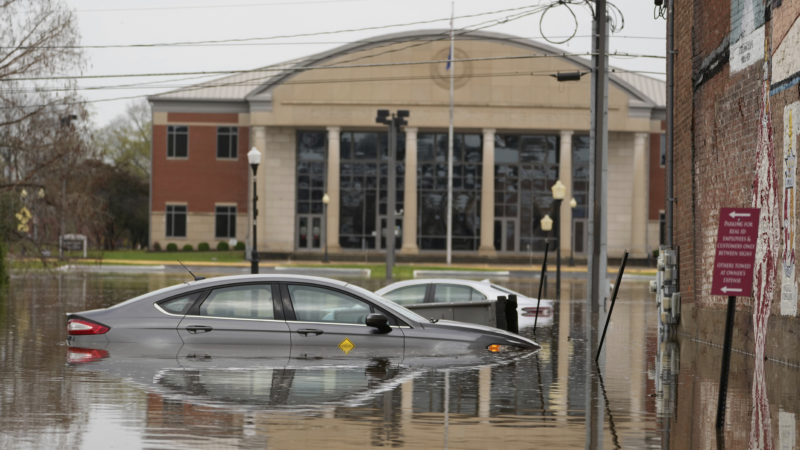More torrential rain and flash flooding are expected in waterlogged South and Midwest
HOPKINSVILLE, Ky. — Another round of torrential rain and flash flooding was coming Saturday for parts of the South and Midwest already heavily waterlogged by days of severe storms that also spawned some deadly tornadoes.
Round after round of heavy rains have pounded the central U.S., rapidly swelling waterways and prompting a series of flash flood emergencies in Missouri, Texas and Arkansas. The National Weather Service said 45 river locations in multiple states were expected to reach major flood stage, with extensive flooding of structures, roads and other critical infrastructure possible.
Many communities on Saturday were surveying the aftermath of tornadoes that destroyed entire neighborhoods and killed at least seven people, and the weather service warned that more twisters were possible in places this weekend. An additional weather-related death was also reported Friday — 9-year-old boy was swept away in flooding and killed, Kentucky’s governor said.
And interstate commerce is affected — the extreme flooding across a corridor that includes Louisville, Kentucky and Memphis — which have major cargo hubs — could lead to shipping and supply chain delays, said Jonathan Porter, chief meteorologist at AccuWeather.
The outburst comes at a time when nearly half of NWS forecast offices have 20% vacancy rates after Trump administration job cuts — twice that of just a decade ago.
Downtown Hopkinsville, Kentucky, reopened early Saturday after floodwaters from the Little River receded, giving a much needed reprieve, but still more rainfall was on its way Saturday and Sunday, Mayor James R. Knight Jr. said.
Torrential rain since Wednesday had turned the downtown of the city of 31,000 into a lake Friday before the bands of weather shifted slightly.
“We got a little rain but most of it went north of us,” Knight said Saturday. “Thank goodness on that. Gave us a little break.”
Flash flood threat looms over many states
Flash flood emergencies continued to be issued Saturday across Arkansas, Mississippi and Tennessee, with more heavy rains and damaging winds in the mix. Weather officials in Tennessee, at least, predicted that the crescendo of severe weather risks would subside after Sunday.
“The finish line is in sight!” NWS Nashville posted on social media.
The worst of it was expected Saturday afternoon and evening in Hopkinsville, where predictions of another 3-4 inches of rain had people filling more sandbags to hold back another potential surge of floodwaters, Christian County Judge-Executive Jerry Gilliam said Saturday.
“We anticipate this water coming back quickly if it comes down quickly,” he said. “There are supposed to be three or four bursts of heavy rains throughout the day.”
A light drizzle was falling on the city as he spoke. Local jail inmates were filling sandbags, and officials allotted 20 bags for each resident, he said.
Hundreds of Kentucky roads were impassable Friday because of floodwaters, downed trees or mud and rock slides, and the number of closures were likely to increase with more rain Saturday, said Kentucky Gov. Andy Beshear.
Flash flooding is particularly worrisome in rural Kentucky where water can rush off the mountains into the hollows. Less than four years ago, dozens died in flooding in the eastern part of the state.
Swollen rivers and tributaries also swamped some parts in Ohio on Friday, and Gov. Mike DeWine said about 70 roads were closed. The southern half of the state was expected to see moderate flooding, which has not happened in four years, he added.
Why so much nasty weather?
Forecasters attributed the violent weather to warm temperatures, an unstable atmosphere, strong wind shear and abundant moisture streaming from the Gulf.
At least two reports of observed tornadoes were noted Friday evening in Missouri and Arkansas, according to the NWS. One, near Blytheville, Arkansas, lofted debris at least 25,000 feet (7.6 kilometers) high, according to weather service meteorologist Chelly Amin. The state’s emergency management office reported damage in 22 counties from tornadoes, wind, hail and flash flooding.
Tennessee Gov. Bill Lee said entire neighborhoods in the hard-hit town of Selmer were “completely wiped out,” after it was hit by a tornado with winds estimated by the NWS of up to 160 mph (257 kph). Advance warning of storms likely saved lives as hundreds of people sheltered at a courthouse, the governor said.
Mississippi’s governor said at least 60 homes were damaged. And in far western Kentucky, four people were injured while taking shelter in a vehicle under a church carport, according to the emergency management office in Ballard County.
Light from satellites will ruin majority of some space telescope images, study says
Astronomers have long been concerned about reflections from satellites showing up in images taken by telescopes and other scientific instruments.
Defense Department is reviewing boat strike video for possible release, Hegseth says
In a speech on Saturday, Defense Secretary Pete Hegseth defended the strikes, saying: "President Trump can and will take decisive military action as he sees fit to defend our nation's interests."
Bama, Miami in, Notre Dame out and Indiana No. 1 in College Football Playoff rankings
Nobody paying attention for the past 24 months would be surprised to see Indiana – yes, Indiana – leading the way into this year's College Football Playoff.
McLaren’s Lando Norris wins first F1 title at season-ending Abu Dhabi Grand Prix
Red Bull driver and defending champion Max Verstappen won the race with Norris placing third, which allowed Norris to finish two points ahead of Verstappen in the season-long standings.
A ban on feeding pigeons ruffles lots of feathers in Mumbai
The pigeon population has exploded — a result of people feeding the birds. For some it's a holy duty and a way to connect to nature. Critics point to health risks tied to exposure to pigeon droppings.
UN humanitarian chief: world needs to ‘wake up’ and help stop violence in Sudan
The UN's top humanitarian and emergency relief official has told NPR that the lack of attention from world leaders to the war in Sudan is the "billion dollar question".








